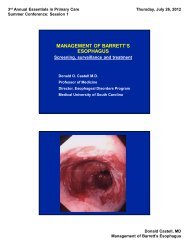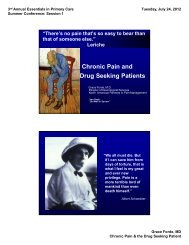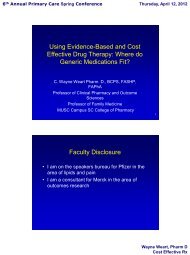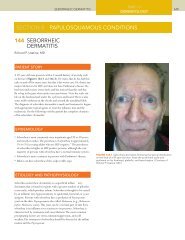New Drug Update 2010-2011 Faculty Disclaimer - CME Conferences
New Drug Update 2010-2011 Faculty Disclaimer - CME Conferences
New Drug Update 2010-2011 Faculty Disclaimer - CME Conferences
Create successful ePaper yourself
Turn your PDF publications into a flip-book with our unique Google optimized e-Paper software.
2 nd Annual Essentials in Primary Care<br />
Fall Conference<br />
Friday, November 11, <strong>2011</strong><br />
Buprenorphine Transdermal System - Butrans<br />
• Transdermal buprenorphine was assessed in a study enrolling 1,160<br />
patients with chronic low back pain currently receiving long-term<br />
opioid therapy (morphine 30 to 80 mg equivalent per day). Patients<br />
entered an open-label, dose-titration period with transdermal<br />
buprenorphine for up to 3 weeks following tapering of prior opioids.<br />
Buprenorphine therapy was initiated with the 10 mcg/h dosage for 3<br />
days and then increased to 20 mcg/h for up to 18 days. Patients with<br />
adequate analgesia and tolerable adverse effects at the 20 mcg/h<br />
dosage were randomized to remain on buprenorphine 20 mcg/h or<br />
were switched to low-dosage control (buprenorphine 5 mcg/h) or an<br />
active control (not specified).<br />
– At least a 30% reduction in pain score from screening to end point was achieved<br />
in 49% of patients treated with the 20 mcg/h dosage compared with 33% of<br />
patients treated with the 5 mcg/h dosage<br />
Buprenorphine Transdermal System - Butrans<br />
• 588 patients with persistent non–cancer-related pain<br />
previously treated with oral opioid combination agents<br />
received transdermal buprenorphine during a 7- to 21-<br />
day open-label titration phase; those achieving stable<br />
pain control (267 patients) were randomized to receive<br />
up to 14 days of buprenorphine at the titrated dose or<br />
placebo.<br />
– Treatment was judged ineffective (requiring more than<br />
acetaminophen 1 g as escape medication on any day of the<br />
double-blind phase, requiring a change in study drug or dose,<br />
having difficulty keeping the patch affixed, or discontinuing<br />
treatment because of a lack of efficacy) in 51.2% of<br />
buprenorphine-treated patients compared with 65% of patients<br />
treated with placebo. The odds of ineffective treatment were 1.79<br />
times greater with placebo than with buprenorphine (P = 0.022).<br />
Wayne Weart<br />
<strong>New</strong> <strong>Drug</strong> <strong>Update</strong> Part I









